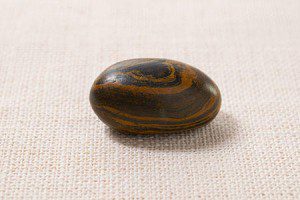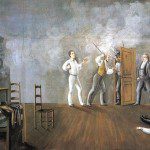
For the lucky few vacationing in isolated corners of the world without internet access, you may have missed the furious hubbub surrounding Joseph Smith’s seer stone. The Church of Jesus Christ of Latter-day Saints in conjunction with the Community of Christ released previously unseen photographs of the stone along with a new volume of manuscripts from the Joseph Smith Papers Project, sparking a conversation among Mormons about its significance and relevance to faith.
Former Peculiar People blogheads Matt Bowman and Ben Park discussed the seer stone with Doug Fabrizio on RadioWest. Listen to it here (and yes, you read that correctly. As of next week, Matt & Ben will be passing on Peculiar People. More on that later).
Here’s what they had to say about the interview, as well as their reflections on this blog.
Ben Park:
“Upon listening to the interview later, I realized how academic I sounded. That was not my original intent, though it also was not a surprise. On the one hand, I think speaking about these touchstone topics in a cool, dispassionate, and detached way emphasize the banality of these issues from a historical perspective, which hopefully alleviates kneejerk consternation; on the other, I wonder if such discourse sounds cold to those who are sincerely and foundationally troubled by what they see as “shocking” revelations.
Peculiar People was meant to speak to that very tension I felt on Tuesday, and I believe we had many, many posts that accomplished bridging the academic/public divide. My alchemic recipe usually involved destabilizing contexts, uprooting traditional narratives, glimpsing personal vulnerability, and sneaking in a few pop culture references. But just like the varieties of Joseph Smith’s revelatory devices, including his seerstones, I learned that there were multiple ways to use what he called our “crooked, broken, scattered and imperfect language” to capture something truly profound. As the blog now shifts to take a different approach, I’m am eager to see what comes of it.”
Matt Bowman:
“Unlike Ben, I am not brave enough to listen to myself being interviewed, but I certainly concur with him that it should be, ideally, part of the role of the academic to communicate the tools we learn from our mentors and each other to people who have neither the time nor inclination to spend our lives as we do.
This particular interview is, I think, a useful microcosm of my attempt, at least, to do that. I received several communications after the interview. Some were complimentary, some were less so, but all used the same word to describe the stones; that being, “weird.” And of course, to most Americans accustomed to the lives we live today, confident in science and suspicious of ghosts and UFOs, they do seem weird.
Part of my job, and perhaps what this blog has tried to do, is to make, as a (slightly tweaked) old chestnut in religious studies puts it, the weird seem normal, and the normal seem weird. That is, we should be helping people see humanity, fears, and desires that they recognize in things that might seem strange—like Joseph’s stone. But we should also help them see how the assumptions and predicates they take for granted might seem odd to others. In that sense, then, the task of academics should be to help us all understand each other better, and in so doing, hopefully to build more cohesive and welcoming societies. That’s a lot of weight to put on one NPR interview, but it is, as anything, a start.”
On behalf of the many enthusiastic bloggers here at Peculiar People, I’d like to thank Matt and Ben for their work and wish them the best on their future endeavors. We do have some interesting ideas in the works for this blog, but we’ll often look back on their contributions for inspiration. Thanks, guys.












